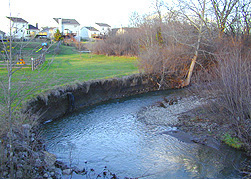
The primary mission of the Butler County Ohio Storm Water District is to safeguard public health and protect the environment through the implementation of the U.S. EPA National Pollutant Discharge Elimination System (NPDES).
Mandated by Congress under the Clean Water Act, the NPDES is a national program for addressing sources of storm water discharges which adversely affect the quality of our nation’s waters. The program requires the implementation of controls designed to prevent harmful pollutants from being washed by storm water runoff into local water bodies.
Storm water discharges are a concern because they contain potentially high levels of pollutants. According to the U.S. EPA, polluted storm water runoff is a leading cause of impairment to the nearly 40 percent of surveyed U.S. water bodies which do not meet water quality standards. Concentrated development substantially increases impervious surfaces, such as city streets, driveways, parking lots, and sidewalks, on which pollutants from human activities settle and remain until a storm event washes them into nearby storm drains. Common pollutants include pesticides, fertilizers, oils, salt, litter and other debris, and sediment. Another concern is the possible illicit connections of septic systems and sanitary sewers, which can result in fecal coliform bacteria entering the storm drain system. Storm water runoff picks up and transports these and other harmful pollutants then discharges them – untreated – to waterways via storm drain systems. When left untreated, these discharges can result in fish kills, the destruction of wildlife and wildlife habitats, a loss in aesthetic value, and contamination of drinking water supplies and recreational waterways that can threaten public health.
Since June 2002, Butler County has actively solicited input from local government and
local interest groups in the development of the Butler County Storm Water District. The purpose of the District is to ensure all member communities (co-permittees) are in compliance with the requirements of the NPDES Phase II permit.
March 2003 marked the beginning of the first permit cycle, which requires the Butler County Storm Water District to fully execute a Storm Water Management Plan (SWMP) within five years. The purpose of this plan is to reduce the discharge of pollutants to the Maximum Extent Practicable (MEP), to protect water quality, and to satisfy the appropriate water quality requirements of Ohio Revised Code (ORC) 6111 and the Clean Water Act.
The SWMP is comprised of six Minimum Control Measures (MCM), including:
- Public education and outreach
- Public involvement and participation
- Elimination of illicit discharges
- Construction site runoff control
- Post-construction runoff control
- Pollution prevention /Good Housekeeping
The SWMP addresses each of the six MCM’s listed above and provides a framework of Best Management Practices (BMP) to improve the quality of runoff to area streams and rivers. The MCM’s are expected to result in the reduction of pollutants discharged within Butler County. Examples of locally identified water quality problems include, but are not limited to, organic enrichment, habitat and flow alteration, nutrients, and siltation. The six MCM’s will address identified water quality pollutants.
Please note: The SWMP addresses water quality issues only. Flooding and drainage issues are not addressed under the NPDES Phase II program. If you would like the Storm Water District to consider flooding and drainage related issues for your community, please contact your elected officials and make them aware of your concerns. The Storm Water District has a program ready to deal with local flooding issues, but it requires a formal request from township and municipal officials to initiate. Additional assessments will be necessary to fund capital improvement projects.
To review the Butler County SWMP in detail, please click on the following link:
Storm Water Management Plan
The following websites can provide additional information concerning the U.S. Environmental Protection Agency NPDES Phase II program:
- U.S. EPA – Storm Water Phase II: Final Rule
https://www.epa.gov/npdes/stormwater-rules-and-notices-final-rules - Ohio EPA – Storm Water Program Phase II Fact Sheet
https://www.epa.gov/npdes/stormwater-phase-ii-final-rule-fact-sheet-series